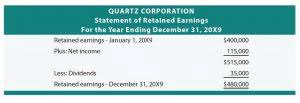Accounting Equation: What It Is and How You Calculate It

Dividends paid to shareholders are entirely at the company’s discretion. If the company chooses to retain profits for internal business investments and expenditures, it is not required to pay dividends to its shareholders. They can save retained earnings, which are added to the balance sheet for the following year as Beginning Period Retained Earnings, and increase retained earnings for that year, thereby increasing the equity. Retained Earnings are profits from net income that are not distributed as dividends to shareholders. Instead, this amount is reinvested in the business for purposes such as funding working capital, purchasing inventory, debt servicing, etc.
Example Transaction #5: Purchase of Advertising on Credit
Property, Plant, and Equipment (also known as PP&E) capture the company’s tangible fixed assets. Some companies will class out their PP&E by the different types of assets, such as Land, Building, and various types of Equipment. Enter your name and email in the form below and download the free template now!
Shareholders’ Equity
After all, the only way to know exactly what a building is worth is to sell it. Total equity effectively represents how much a company would have left over in assets if the company went out of business immediately. As such, many investors view companies with negative equity as risky or unsafe. However, many individuals use it in conjunction with other financial metrics to gauge the soundness of a company.

Balance Sheet Formats
A company usually must provide a balance sheet to a lender in order to secure a business loan. A company must also usually provide a balance sheet to private investors when attempting to secure private equity funding. In both cases, the external party wants to assess the financial health of a company, the creditworthiness of the business, and whether the company will be able to repay its short-term assets liabilities equity formula debts. Stockholders’ equity plays a crucial role in evaluating a company’s financial health and performance. It serves as a buffer against losses and liabilities, indicating whether the company has sufficient funds to settle its obligations. A positive stockholders’ equity indicates a strong financial position, while a negative balance or equity deficit can signal potential insolvency.
Example of How To Use Net Asset Value Per Share – NAVPS

Retained earnings are calculated by first adding the beginning retained earnings (from the previous year’s balance sheet) to the net income or loss and subtracting dividends paid to shareholders. You can think about equity in terms of what would happen if the company went bankrupt and liquidated its assets today. If that $20 was net profit, it goes toward the owner’s equity in the business. By definition, https://www.bookstime.com/articles/accrual-to-cash-conversion a company’s assets minus its liabilities equals its stockholders’ equity (also known as “net equity”). In other words, the liabilities and stockholders’ equity “balance out” the assets — which is why it’s called a balance sheet. If the total liabilities calculated equals the difference between assets and equity then an organization has correctly gauged the value of all three key components.

Limitations of a Balance Sheet
- Upon calculating the total assets and liabilities, company or shareholders’ equity can be determined.
- Double-entry accounting is a system where every transaction affects at least two accounts.
- The difference between the $400 income and $250 cost of sales represents a profit of $150.
- The accounting equation states that a company’s total assets are equal to the sum of its liabilities and its shareholders’ equity.
All three metrics are readily found on the balance sheet of any publicly traded company. However, for privately held businesses, assets and liabilities should be relatively straightforward to calculate (or at least estimate), and therefore, stockholders’ equity can be found. Looking at the same period one year earlier, we can see that the year-on-year change in equity was a decrease of $25.15 billion. The balance sheet shows this decrease is due to both a reduction in assets and an increase in total liabilities. Here we see that the sum of liabilities and equity equals the total assets and the equation balances.
What Is the Accounting Equation?
- In both cases, the external party wants to assess the financial health of a company, the creditworthiness of the business, and whether the company will be able to repay its short-term debts.
- Capital essentially represents how much the owners have invested into the business along with any accumulated retained profits or losses.
- The financial statement only captures the financial position of a company on a specific day.
- Unlike public corporations, private companies do not need to report financials nor disclose financial statements.
- Otherwise, you will need to manually add your liabilities up in your spreadsheet or the software of your choice.
